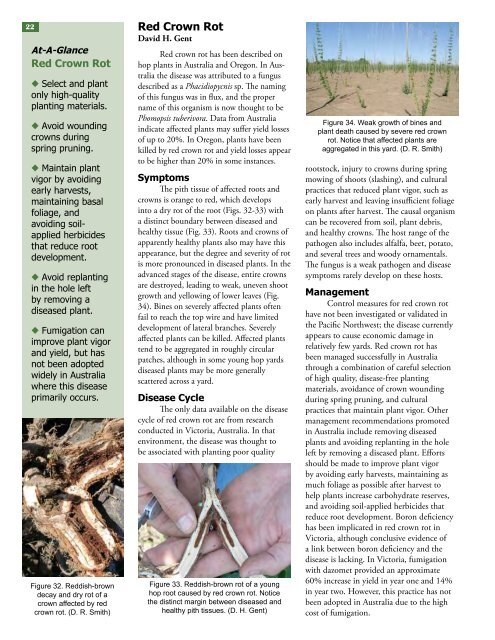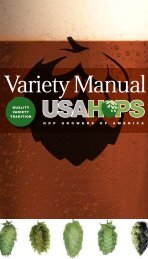Field Guide for Integrated Pest Management in Hops
Field Guide for Integrated Pest Management in Hops
Field Guide for Integrated Pest Management in Hops
You also want an ePaper? Increase the reach of your titles
YUMPU automatically turns print PDFs into web optimized ePapers that Google loves.
22At-A-GlanceRed Crown Rot◆◆Select and plantonly high-qualityplant<strong>in</strong>g materials.◆◆Avoid wound<strong>in</strong>gcrowns dur<strong>in</strong>gspr<strong>in</strong>g prun<strong>in</strong>g.◆◆Ma<strong>in</strong>ta<strong>in</strong> plantvigor by avoid<strong>in</strong>gearly harvests,ma<strong>in</strong>ta<strong>in</strong><strong>in</strong>g basalfoliage, andavoid<strong>in</strong>g soilappliedherbicidesthat reduce rootdevelopment.◆◆Avoid replant<strong>in</strong>g<strong>in</strong> the hole leftby remov<strong>in</strong>g adiseased plant.◆◆Fumigation canimprove plant vigorand yield, but hasnot been adoptedwidely <strong>in</strong> Australiawhere this diseaseprimarily occurs.Figure 32. Reddish-browndecay and dry rot of acrown affected by redcrown rot. (D. R. Smith)Red Crown RotDavid H. GentRed crown rot has been described onhop plants <strong>in</strong> Australia and Oregon. In Australiathe disease was attributed to a fungusdescribed as a Phacidiopycnis sp. The nam<strong>in</strong>gof this fungus was <strong>in</strong> flux, and the propername of this organism is now thought to bePhomopsis tuberivora. Data from Australia<strong>in</strong>dicate affected plants may suffer yield lossesof up to 20%. In Oregon, plants have beenkilled by red crown rot and yield losses appearto be higher than 20% <strong>in</strong> some <strong>in</strong>stances.SymptomsThe pith tissue of affected roots andcrowns is orange to red, which develops<strong>in</strong>to a dry rot of the root (Figs. 32-33) witha dist<strong>in</strong>ct boundary between diseased andhealthy tissue (Fig. 33). Roots and crowns ofapparently healthy plants also may have thisappearance, but the degree and severity of rotis more pronounced <strong>in</strong> diseased plants. In theadvanced stages of the disease, entire crownsare destroyed, lead<strong>in</strong>g to weak, uneven shootgrowth and yellow<strong>in</strong>g of lower leaves (Fig.34). B<strong>in</strong>es on severely affected plants oftenfail to reach the top wire and have limiteddevelopment of lateral branches. Severelyaffected plants can be killed. Affected plantstend to be aggregated <strong>in</strong> roughly circularpatches, although <strong>in</strong> some young hop yardsdiseased plants may be more generallyscattered across a yard.Disease CycleThe only data available on the diseasecycle of red crown rot are from researchconducted <strong>in</strong> Victoria, Australia. In thatenvironment, the disease was thought tobe associated with plant<strong>in</strong>g poor qualityFigure 33. Reddish-brown rot of a younghop root caused by red crown rot. Noticethe dist<strong>in</strong>ct marg<strong>in</strong> between diseased andhealthy pith tissues. (D. H. Gent)Figure 34. Weak growth of b<strong>in</strong>es andplant death caused by severe red crownrot. Notice that affected plants areaggregated <strong>in</strong> this yard. (D. R. Smith)rootstock, <strong>in</strong>jury to crowns dur<strong>in</strong>g spr<strong>in</strong>gmow<strong>in</strong>g of shoots (slash<strong>in</strong>g), and culturalpractices that reduced plant vigor, such asearly harvest and leav<strong>in</strong>g <strong>in</strong>sufficient foliageon plants after harvest. The causal organismcan be recovered from soil, plant debris,and healthy crowns. The host range of thepathogen also <strong>in</strong>cludes alfalfa, beet, potato,and several trees and woody ornamentals.The fungus is a weak pathogen and diseasesymptoms rarely develop on these hosts.<strong>Management</strong>Control measures <strong>for</strong> red crown rothave not been <strong>in</strong>vestigated or validated <strong>in</strong>the Pacific Northwest; the disease currentlyappears to cause economic damage <strong>in</strong>relatively few yards. Red crown rot hasbeen managed successfully <strong>in</strong> Australiathrough a comb<strong>in</strong>ation of careful selectionof high quality, disease-free plant<strong>in</strong>gmaterials, avoidance of crown wound<strong>in</strong>gdur<strong>in</strong>g spr<strong>in</strong>g prun<strong>in</strong>g, and culturalpractices that ma<strong>in</strong>ta<strong>in</strong> plant vigor. Othermanagement recommendations promoted<strong>in</strong> Australia <strong>in</strong>clude remov<strong>in</strong>g diseasedplants and avoid<strong>in</strong>g replant<strong>in</strong>g <strong>in</strong> the holeleft by remov<strong>in</strong>g a diseased plant. Ef<strong>for</strong>tsshould be made to improve plant vigorby avoid<strong>in</strong>g early harvests, ma<strong>in</strong>ta<strong>in</strong><strong>in</strong>g asmuch foliage as possible after harvest tohelp plants <strong>in</strong>crease carbohydrate reserves,and avoid<strong>in</strong>g soil-applied herbicides thatreduce root development. Boron deficiencyhas been implicated <strong>in</strong> red crown rot <strong>in</strong>Victoria, although conclusive evidence ofa l<strong>in</strong>k between boron deficiency and thedisease is lack<strong>in</strong>g. In Victoria, fumigationwith dazomet provided an approximate60% <strong>in</strong>crease <strong>in</strong> yield <strong>in</strong> year one and 14%<strong>in</strong> year two. However, this practice has notbeen adopted <strong>in</strong> Australia due to the highcost of fumigation.








